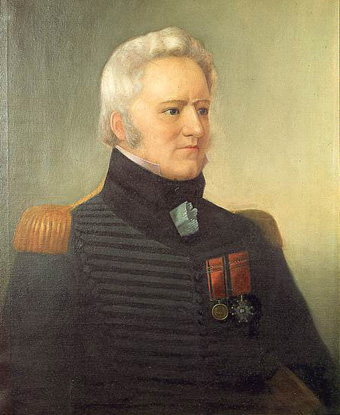Last updated: April 21, 2015
Person
Charles de Salaberry

Museum of Château Ramezay, Montréal
Charles-Michel d’Irumberry de Salaberry was born into a French Canadian military family who had served for generations. His father, Ignace-Michel-Louis-Antoine d’Irumberry de Salaberry, was a former British officer and served on the Legislative Assembly of Lower Canada. Following in his father’s footsteps, at the age of 14, Charles enlisted in the British army in the 44th Regiment of Foot.
Salaberry spent the French Revolution in the Caribbean and was part of successful invasions of Saint-Dominique, Guadeloupe and Martinique. He was slowly promoted throughout the Napoleonic Wars, serving in Britain and Ireland. Eventually he was posted to the Canadas in June 1810 to serve as aide-de-camp of Colonel Francis de Rottenburg, his former commander from Ireland.
He was promoted to brevet major July 2, 1811, and began creating a new corps of volunteers, les Voltigeurs canadiens. Salaberry’s passion for a French Canadian defense, his growing reputation as a strong leader, and a poor economy made recruiting easy. Salaberry’s vision for les Voltigeurs came together by the spring of 1812. Although known as a strict, demanding officer, Salaberry was also well-respected by his troops. He held his volunteers to the same exacting standards of the regular army units, demanding loyalty, discipline, and professionalism. This respect, along with his understanding of the delicate position commanding French Canadians to fight alongside the British earned him in turn respect and trust from the troops he led.
Salaberry’s unit of Voltigeurs fought in the advance guard at Lacolle Mill in November 1812 that repulsed Henry Dearborn’s northern attack, and again against a combined American attack at the Chateâuguay River on October 21, 1813. This protected Montréal from American invasion, showcased the contributions of French Canadians in the war effort, and elevated Salaberry to the level of war hero.
Despite his popularity and success, as a French Catholic, Salaberry recognized that he was unlikely to rise any higher in the ranks of the British army. He retired in January 1814 after a long and successful career.
After the war, Salaberry continued to follow in his father’s footsteps by becoming a justice of the peace back at his home in Québec, and later joined his father in serving on the legislative council of Lower Canada. He married Marie-Anne-Julie Hertel de Rouville and had seven children. He amassed much wealth and a large estate through investments in transportation infrastructure. Following his father’s death in 1828, Salaberry became the Seigneur of St. Mathias, overseeing the community of Chambly, Québec, where he lived out the rest of his life.
